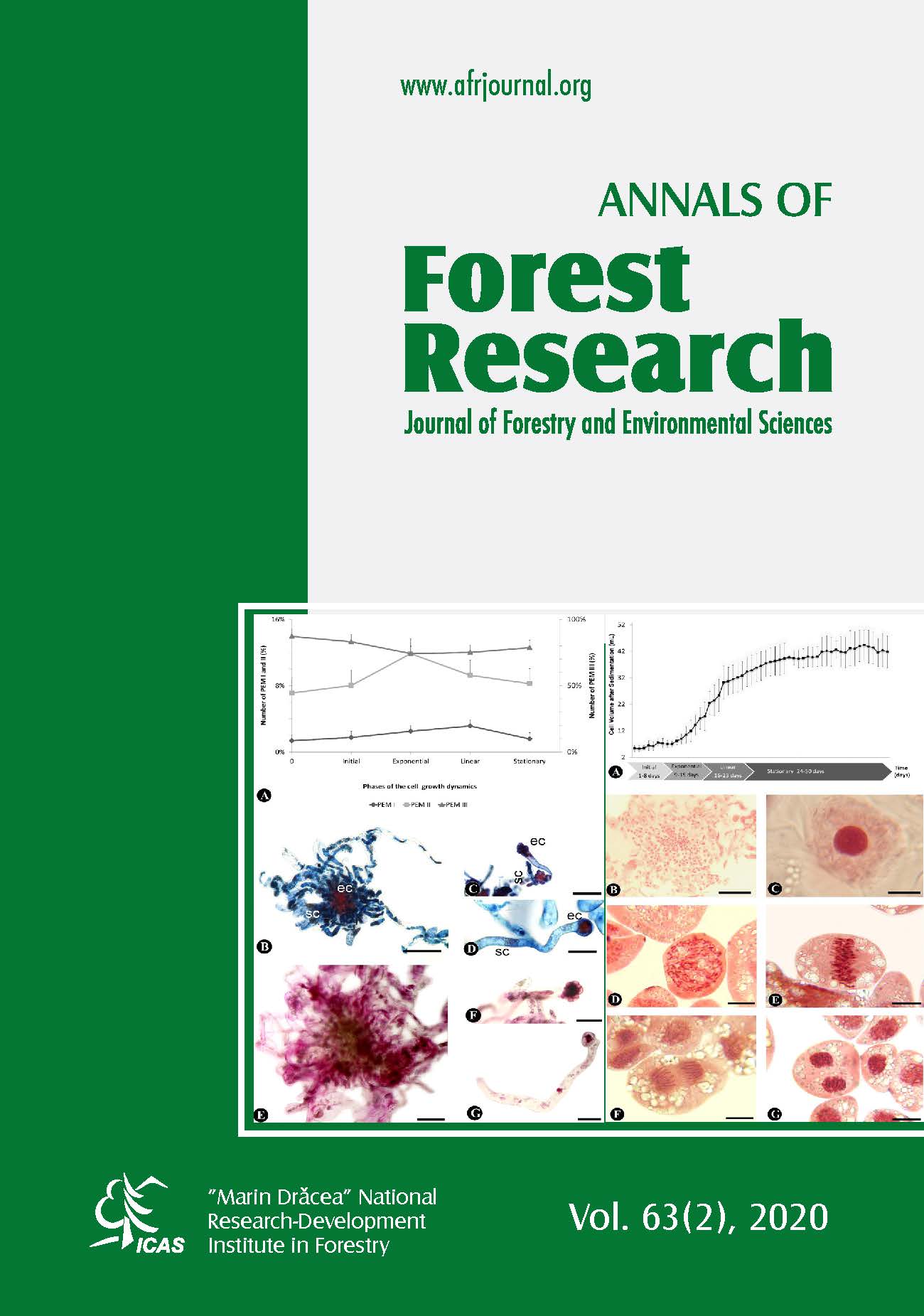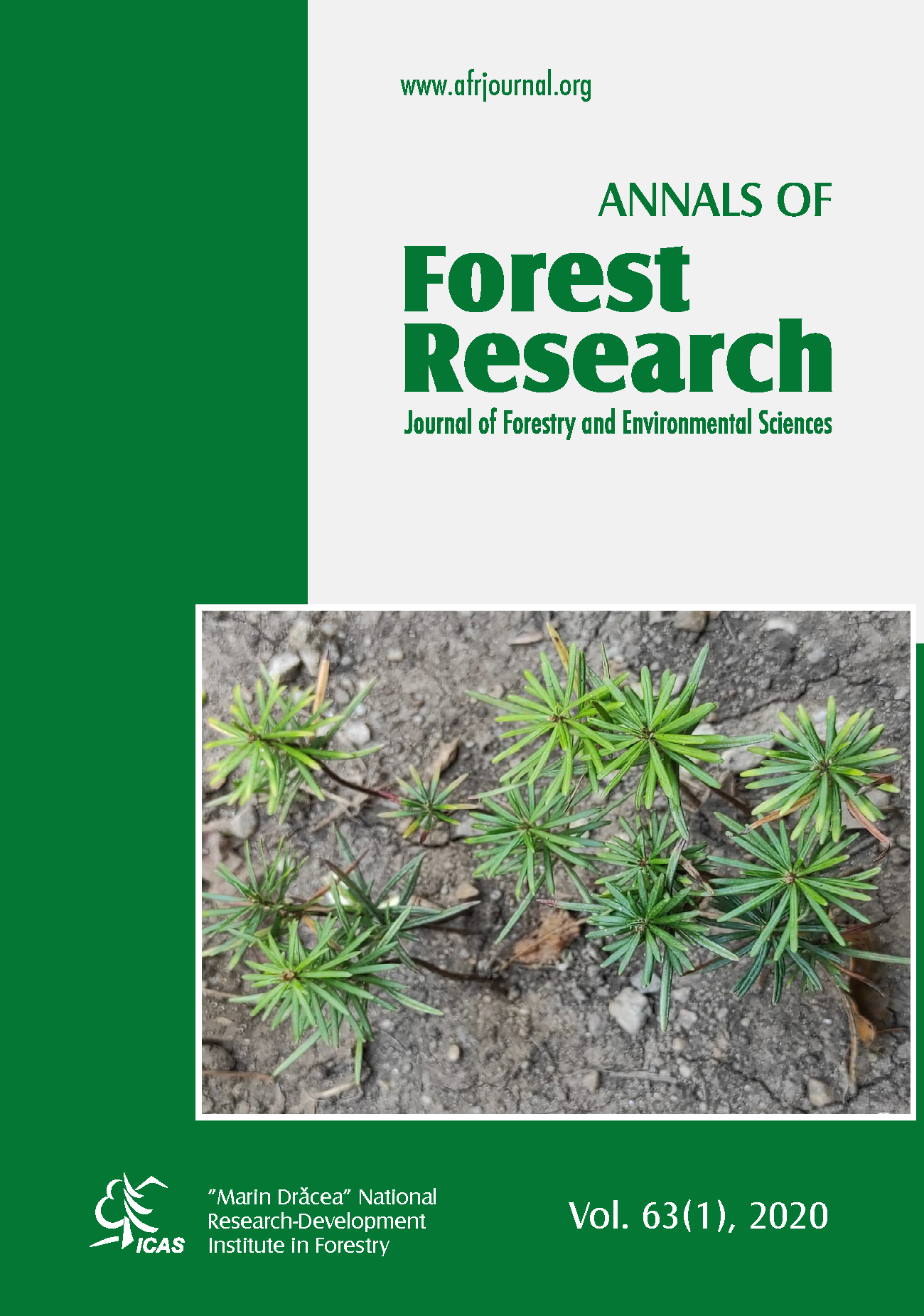Analyses of molecular markers and leaf morphology of two rare birches, Betula obscura and B. pendula var. carelica
DOI:
https://doi.org/10.15287/afr.2020.1973Keywords:
ADH gene, AFLP, hybridization, ITS, morphological variationAbstract
Trees and shrubs belonging to the Betula L. genus seem to represent one of the most confused interspecific relationships, and hybridization is considered to be one of the main factors responsible for the substantial genetic and morphological variation of birches. In the present investigation, the internal transcribed spacer ITS1 and ITS2 regions of nuclear ribosomal DNA, nuclear alcohol dehydrogenase (ADH) gene sequences and amplified fragment length polymorphisms (AFLPs) as well as the Atkinson discriminant function (ADF) of leaf morphology were used to verify hypotheses concerning the origin of the dark barked Betula obscura and B. pendula var. carelica with the patterned wood. Both plants were considered by different authors to be distinct species, intraspecific forms of common B. pendula or B. pubescens, or hybrid taxa between B. pendula and B. pubescens. In the phylogenetic trees, the ITS and ADH gene sequences of both B. obscura and B. pendula var. carelica clustered with those of B. pendula, whereas B. pubescens trees were somewhat distinct. In turn, the AFLPs revealed genetic similarity of B. pendula var. carelica to both frequent species, whereas B. obscura was clearly distinct from other birches. Values of the ADF indices of the rare birches were typical for B. pendula. In the light of the results obtained, we imply that B. obscura and B. pendula var. carelica represent an intraspecific variation of B. pendula, they are neither intraspecific taxa of B. pubescens nor hybrid species between the common birches. Different grouping of B. obscura in the AFLPs and DNA sequences analyses is likely a result of an unreliable phylogenetic signal of the former molecular markers.References
Abbott R., Albach D., Ansell S., Arntzen J.W., Baird S.J., Bierne N., Boughman J., Brelsford A., Buerkle C.A., Buggs R., et al., 2013. Hybridization and speciation. Journal of Evolutionary Biology 26: 229–246. DOI: 10.1111/j.1420-9101.2012.02599.xAbbott R.J., Rieseberg L.H., 2012. Hybrid speciation. In: eLS. John Wiley & Sons, Ltd: Chichester. DOI: 10.1002/9780470015902.a0001753.pub2Ahokas H., 1985. Cytokinins in the spring sap of curly birch (Betula pendula f. carelica) and the non-curly form. Plant Physiology 118(1): 33–39. DOI: 10.1016/S0176-1617(85)80162-0Anamthawat-Jónsson K., 2019. Hybrid introgression: the outcomes of gene flow in birch. ScienceAsia 45: 203–211. DOI: 10.2306/scienceasia1513-1874.2019.45.203Ashburner K., McAllister H.A., 2016. The Genus Betula: A taxonomic revision of birches. Kew Publishing, London.Atkinson M. D., Codling A.N., 1986. A reliable method for distinguishing between Betula pendula and B. pubescens. Watsonia 7: 5–6.Beck P., Caudullo G., de Rigo D., Tinner W., 2016. Betula pendula, Betula pubescens and other birches in Europe: distribution, habitat, usage and threats. In: San-Miguel-Ayanz J., de Rigo D., Caudullo G., Houston Durrant T., Mauri A. (eds.), European atlas of forest tree species. Publ. Off. EU, Luxembourg, pp. 70–73.Bina H., Yousefzadeh H., Ali S.S., Esmailpour M., 2016. Phylogenetic relationships, molecular taxonomy, biogeography of Betula, with emphasis on phylogenetic position of Iranian populations. Tree Genetics & Genomes 12: 84. DOI: 10.1007/s1129 5-016-1037-4Bona A., Petrova G., Jadwiszczak K.A., 2018. Unfavourable habitat conditions can facilitate hybridisation between the endangered Betula humilis and its widespread relatives B. pendula and B. pubescens. Plant Ecology & Diversity 11(3): 295–306. DOI: 10.1080/17550874.2018.1518497Boni M.F., Posada D., Feldman M.W., 2007. An exact non-parametric method for inferring mosaic structure in sequence triplets. Genetics 176(2): 1035–1047. DOI: 10.1534/genetics.106.068874Bonin A., Bellemain E., Eidesen B.P., Pompanon F., Brochmann C., Taberlet P., 2004. How to track and assess genotyping errors in population genetics studies. Molecular Ecology 13(11): 3261–3273. DOI: 10.1111/j.1365-294X.2004.02346.xBrown I. R., Kennedy D., Williams D.A., 1982. The occurrence of natural hybrids between Betula pendula Roth and B. pubescens Ehrh. Watsonia 14: 133-145.Butorina A. K., 1985. Tsitogenetika ekonomicheski vazhnykh form karel'skoy berezy [Cytogenetics of economically important forms of Karelian birch]. Genetika (Moscow) 21: 1192– 1198.Butorina A. K., 1993. O prirode uzorchatosti drevesiny u karel'skoy berezy. In: Geneticheskiye i ekologicheskiye osnovy povysheniya produktivnosti lesov [On the nature of wood patterning in Karelian birch. In: Genetic and ecological basis for increasing forest productivity]. State University of Forestry and Technologies, Voronezh, Russia.Després L., Gielly L., Redoutet B., Taberlet P., 2003. Using AFLP to resolve phylogenetic relationships in a morphologically diversified plant species complex when nuclear and chloroplast sequences fail to reveal variability. Molecular Phylogenetics and Evolution 27(2): 185–196. DOI: 10.1016/S1055-7903(02)00445-1Dubois H., Verkasalo E., Claessens H., 2020. Potential of birch (Betula pendula Roth and B. pubescens Ehrh.) for forestry and forest-based industry sector within the changing climatic and socio-economic context of western Europe. Forests 11(3): 336. DOI: 10.3390/f11030336Earl D.A., vonHoldt B.M., 2012. STRUCTURE HARVESTER: a website and program for visualizing STRUCTURE output and implementing the Evanno method. Conservation Genetics Resources 4: 359–361. DOI 10.1007/s12686-011-9548-7Eidesen, P.B., Alsos I.G., Brochmann C., 2015. Comparative analyses of plastid and AFLP data suggest different colonization history and asymmetric hybridization between Betula pubescens and B. nana. Molecular Ecology 24(15): 3993–4009. DOI: 10.1111/mec.13289Ellstrand N.C., 1992. Gene flow among seed plant populations. New Forests 6: 241–252. DOI: 10.1007/BF00120647Ellstrand N.C., Schierenbeck K.A., 2006. Hybridization as a stimulus for the evolution of invasiveness in plants? Euphytica 148: 35–46. DOI: 10.1007/s10681-006-5939-3Ermakov V.I., 1986. Mekhanizmy adaptatsii berezy k usloviyam Severa [Birch adaptation mechanisms to the conditions of the North]. Nauka, Leningrad, Russia.Evanno G., Regnaut S., Goudet J., 2005. Detecting the number of clusters of individuals using the software STRUCTURE: a simulation study. Molecular Ecology 14(8): 2611–2620. DOI: 10.1111/j.1365-294X.2005.02553.xFalush D., 2007. Inference of population structure using multilocus genotype data: dominant markers and null alleles. Molecular Ecology Resources 7(4): 574–578. DOI: 10.1111/j.1471-8286.2007.01758.xFraniel I., 2009. Problemy taksonomiczne Betula obscura (Betulaceae) – przegląd literatury Fragmenta Floristica et Geobotanica - Series Polonica 16(1): 27–32.Gausmann P., Loos G.H., 2014. Morphologie und Variationsbreite der Bastard-birke (Betula × aurata Borkh., Betulaceae) auf urban-industriell geprägten Standorten im Ruhrgebiet [Morphology and range of variation of the hybrid birch (Betula × aurata Borkh., Betulaceae) on urban-industrial locations in the Ruhr area]. Floristische Rundbriefe 47: 96–117.Gibbs M.J., Armstrong J.S., Gibbs A.J., 2000. Sister-Scanning: a Monte Carlo procedure for assessing signals in recombinant sequences. Bioinformatics 16(7): 573–582. DOI: 10.1093/bioinformatics/16.7.573Godina D., Paze A., Rizhikov J., Stankus K., Virsis I., Nakurte I., 2018. Stability studies of bioactive compounds from birch outer bark ethanolic extracts. Key Engineering Materials 762: 152–157. DOI: 10.4028/www.scientific.net/KEM.762.152Govaerts R., 2017. WCSP: World Checklist of selected plant families (version Aug 2017). In: Roskov Y., Ower G., Orrell T., Nicolson D., Bailly N., Kirk P.M., Bourgoin T., DeWalt R.E., Decock W., van Niekerken E., Zarusshi J., Peney L (eds.), Species 2000 & ITIS Catalogue of life, Available at www.catalogueoflife.org/col. Species 2000: Naturalis, Leiden, the Netherlands. Accessed 27 Jul 2020.Hall T.A., 1999. BioEdit: A user-friendly biological sequence alignment editor and analysis program for Windows 95/98/NT. Nucleic Acids Symposium Series 41: 95–98. DOI: 10.14601/Phytopathol_Mediterr-14998u1.29Hammer Ø., Harper D.A.T, Ryan P.D., 2001. Paleontological statistics software: package for education and data analysis. Palaeontologia Electronica 4(1): article4. 9.Hasegawa M., Kishino H., Yano T., 1985. Dating of the human-ape splitting by a molecular clock of mitochondrial DNA. Journal of Molecular Evolution 22(2): 160–174. DOI: 10.1007/BF02101694Hämet-Ahti L., 1992. Suomen puu- ja pensaskasvio. Dendrologian Seura r.y., Helsinki.Hodkinson T., Renvoize S., Chonghaile G., Stapleton C.M.A., Chase M.W., 2000. A comparison of ITS nuclear rDNA sequence data and AFLP markers for phylogenetic studies in Phyllostachys (Bambusoideae, Poaceae). Journal of Plant Research 113: 259–269. DOI: 10.1007/PL00013936Hrynkiewicz-Sudnik J., 1962. Zmienność i rozmieszczenie brzozy czarnej (Betula obscura A. Kotula) w Polsce [Variation and distribution of black birch (Betula obscura A. Kotula) in Poland]. Arboretum Kórnickie 7: 5–97.Huang J., Corke H., Sun M., 2002. Highly polymorphic AFLP markers as a complementary tool to ITS sequences in assessing genetic diversity and phylogenetic relationships of sweetpotato (Ipomoea batatas (L.) Lam.) and its wild relatives. Genetic Resources and Crop Evolution 49: 541–550. DOI: 10.1023/A:1021290927362Isidorov V.A., Stocki M., Vetchinnikova L., 2019. Inheritance of specific secondary volatile metabolites in buds of white birch Betula pendula and Betula pubescens hybrids. Trees 33: 1329–1344. DOI: 10.1007/s00468-019-01861-2Isidorov V.A., Szczepaniak L., Wróblewska A., Pirożnikow E., Vetchinnikova L., 2014. Gas chromatographic-mass spectrometric examination of chemical composition of two Eurasian birch (Betula L.) bud exudates and its taxonomical implication. Biochemical Systematics and Ecology 52: 41–48. DOI: 10.1016/j.bse.2013.12.008Järvinen P., Palmé A., Morales L. O., Lännenpää M., Keinänen M., Sopanen T., Lascoux M., 2004. Phylogenetic relationships of Betula species (Betulaceae) based on nuclear ADH and chloroplast matK sequences. American Journal of Botany 91(11): 1834–1845. DOI: 10.3732/ajb.91.11.1834Koopman W. J. M., 2005. Phylogenetic signal in AFLP data sets. Systematic Biology 54(2): 197–217. DOI: 10.1080/10635150590924181Kosman E., Leonard K.J., 2005. Similarity coefficients for molecular markers in studies of genetic relationships between individuals for haploid, diploid, and polyploid species. Molecular Ecology 14(2): 415–424. DOI: 10.1111/j.1365-294X.2005.02416.xKosonen M., 2004. Visakoivu: Curly birch. Metsäkustannus Oy, Finland.Li J., Shoup S., Chen Z., 2005. Phylogenetics of Betula (Betulaceae) inferred from sequences of nuclear ribosomal DNA. Rhodora 107(929): 69–86. DOI:10.3119/04-14.1Lyubavskaya A.Ya. 1978. Karel'skaya bereza [Karelian birch]. Moscow: Publishing House Forest Industry.Martin D.P., Murrell B., Golden M., Khoosal A., Muhire B., 2015. RDP4: detection and analysis of recombination patterns in virus genomes. Virus Evolution 1: vev003. DOI: 010.1093/ve/vev1003Martin D.P., Williamson C., Posada D., 2005. RDP2: recombination detection and analysis from sequence alignments. Bioinformatics 21: 260–262. DOI: 10.1093/bioinformatics/bth490Mashkina O.S, Butorina A.K., Tabatskaya T.M., 2011. Karelian birch (Betula pendula Roth. var. carelica Merkl.) as a model for studying genetic and epigenetic variation related to the formation of patterned wood. Russian Journal of Genetics 47(8): 951–957. DOI: 10.1134/S1022795411080126Meirmans P.G., Liu S., van Tienderen P.H., 2018. The analysis of polyploid genetic data. Journal of Heredity 109: 283–296. DOI: 10.1093/jhered/esy006Meirmans P.G., Van Tienderen P.H., 2004. GENOTYPE and GENODIVE: two programs for the analysis of genetic diversity of asexual organisms. Molecular Ecology Notes 4(4): 792–794. DOI: 10.1111/j.1471-8286.2004.00770.xNagamitsu T., Kawahara T., Kanazashi A., 2006. Endemic dwarf birch Betula apoiensis (Betulaceae) is a hybrid that originated from Betula ermanii and Betula ovalifolia. Plant Species Biology 21: 19–29. DOI: 10.1111/j.1442-1984.2006.00147.xOliver T.H., Heard M.S., Isaac N.J.B., Roy D.B., Procter D., Eigenbrod F., Freckleton R., Hector A., Orme C.D.L., …, Bullock J. M., 2015. Biodiversity and resilience of ecosystem functions. Trends in Ecology & Evolution 30(11): 673-684. DOI: 10.1016/j.tree.2015.08.009Padidam M., Sawyer S., Fauquet C.M., 1999. Possible emergence of new geminiviruses by frequent recombination. Virology 265: 218–225. DOI: 10.1006/viro.1999.0056Pawłowska L., 1982. Flavonoids in the leaves of Polish species of the genus Betula L. V. The taxonomic position on the basis of flavonoid composition. Acta Societatis Botanicorum Poloniae 51: 413–421.Pobirushko V.F., 1992. Ekologo-biologicheskiye osobennosti i vnutrividovaya izmenchivost' nekotorykh vidov roda Betula L. na granitsakh arealov (v usloviyakh Belarusi) [Ecological and biological features and intraspecific variability of some species of the genus Betula L. at the boundaries of ranges (in Belarus)]. Ph. D. Thesis, Institute of Experimental Botany, National Academy of Sciences, Minsk, Belarus.Posada D., Crandall K. A., 2001. Evaluation of methods for detecting recombination from DNA sequences: computer simulations. Proceedings of the National Academy of Sciences of the United States of America 98(24): 13757–13762. DOI: 10.1073/pnas.241370698Pritchard J.K., Stephens M., Donnelly P., 2000. Inference of population structure using multilocus genotype data. Genetics 155: 945–959.Rhymer J.M., Simberloff D., 1996. Extinction by hybridization and introgression. Annual Review of Ecology, Evolution, and Systematics 27: 83–109. DOI: 10.1146/annurev.ecolsys.27.1.83Rieseberg L.H., Kim S.C., Randell R.A., Whitney K.D., Gross B.L., Lexer C., Clay K., 2007. Hybridization and the colonization of novel habitats by annual sunflowers. Genetica 129: 149–165. DOI: 10.1007/s10709-006-9011-yRonquist F., Teslenko M., van der Mark P., Ayres D.L., Darling A., Höhna S., Larget B., Liu L., Suchard M.A., Huelsenbeck J. P., 2012. MrBayes 3.2: efficient Bayesian phylogenetic inference and model choice across a large model space. Systematic Biology 61(3): 539–542. DOI: 10.1093/sysbio/sys029Rozas J., Ferrer-Mata A., Sánchez-Del Barrio J. C., Guirao-Rico S., Librado P., Ramos-Onsins S. E., Sánchez-Gracia A., 2017. DnaSP 6: DNA sequence polymorphism analysis of large datasets. Molecular Biology and Evolution 34(12): 3299–3302. DOI: 10.1093/molbev/msx248Salminen M.O., Carr J.K., Burke D.S., Mccutchan F.E., 1995. Identification of breakpoints in intergenotypic recombinants of HIV type-1 by Bootscanning. AIDS Research and Human Retroviruses 11(11): 1423–1425. DOI: 10.1089/aid.1995.11.1423Schenk M.F., Thienpont C.N., Koopman W.J.M., Gilissen L.J.W.J., Smulders M.J.M., 2008. Phylogenetic relationships in Betula (Betulaceae) based on AFLP markers. Tree Genetics & Genomes 4: 911–924. DOI: 10.1007/s11295-008-0162-0Schumer M., Cui R., Rosenthal G.G., Andolfatto P., 2017. Reproductive isolation of hybrid populations driven by genetic incompatibilities. PLoS Genet 11(3): e1005041. DOI: 10.1371/journal.pgen.1005041Servedio M.R., Noor M.A.F., 2003. The role of reinforcement in speciation: theory and data. Annual Review of Ecology, Evolution, and Systematics 34: 339–364. DOI: 10.1146/annurev.ecolsys.34.011802.132412Smith J. M., 1992. Analyzing the mosaic structure of genes. Journal of Molecular Evolution 34: 126–129. DOI: 10.1007/BF00182389Tamura K., Dudley J., Nei M., Kumar S., 2007. MEGA4: molecular evolutionary genetics analysis (MEGA) software version 4.0. Molecular Biology and Evolution 24(8): 1596–1599. DOI: 10.1093/molbev/msm092Tarieiev A., Olshanskyi I., Gailing O., Krutovsky K. V., 2019. Taxonomy of dark- and white-barked birches related to Betula pendula and B. pubescens (Betulaceae) in Ukraine based on both morphological traits and DNA markers. Botanical Journal of the Linnean Society 191(1): 142–154. DOI: 10.1093/botlinnean/boz031Tavaré S., 1986. Some probabilistic and statistical problems in the analysis of DNA sequences. In: Miura R. M. (ed.), Some mathematical questions in biology - DNA sequence analysis. Providence (RI): American Mathematical Society, pp. 57–86.Vetchinnikova L.V., Titov A.F., 2017. The origin of the Karelian birch: an ecogenetic hypothesis. Russian Journal of Genetics: Applied Research 7(6): 665–677. DOI: 10.1134/S2079059717060144Vetchinnikova L.V., Titov A. F., 2020. The Karelian birch: a unique biological object. Biology Bulletin Reviews 10: 102–114. DOI: 10.1134/S2079086420020085Vetchinnikova L.V., Titov A.F., Kuznetsova T.Yu., 2013. Karel'skaya bereza: biologicheskiye osobennosti, dinamika resursov i vosproizvodstvo [Karelian birch: biological features, resource dynamics and reproduction]. Petrozavodsk: KarNTs RAN.Vos P., Hogers R., Bleeker M., Reijans M., van de Lee T., Hornes M., Frijters A., Pot J., Peleman J., Kuiper M., Zabeau M., 1995. AFLP: a new technique for DNA fingerprinting. Nucleic Acids Research 23(21): 4407–4414. DOI: 10.1093/nar/23.21.4407Wang N., Borrell J.S., Buggs R.J.A., 2014. Is the Atkinson discriminant function a reliable method for distinguishing between Betula pendula and B. pubescens (Betulaceae)? New Journal of Botany 4(2): 90–94 DOI: 10.1179/2042349714Y.0000000044Wang N., Kelly L., McAllister H.A., Zohren J., Buggs R.J.A., 2020. Resolving phylogeny and polyploid parentage using genus-wide genome-wide sequence data from birch trees. Project: Phylogenomics of Betula (Betulaceae). Available at: https://www.biorxiv.org/content/10.1101/2020.07.13.200444v1 Accessed 14 Dec 2020.Wang N., McAllister H.A., Bartlett P., Buggs R.J.A., 2016. Molecular phylogeny and genome size evolution of the genus Betula (Betulaceae). Annals of Botany 117(6): 1023–1035. DOI: 10.1093/aob/mcw048White T.J., Bruns T., Lee S., Taylor J., 1990. Amplification and direct sequencing of fungal ribosomal RNA genes for phylogenetics. In: Innis M.A., Gelfand D.H., Sninsky J.J., White T.J. (eds.), PCR protocols: a guide to methods and applications. New York: Academic Press.Whitney K.D., Ahern J.R., Campbell L.G., Albert L.P., King M.S., 2010. Patterns of hybridization in plants. Perspectives in Plant Ecology, Evolution and Systematics 12: 175–182. DOI: 10.1016/j.ppees.2010.02.002Zaverukha B. V., 1964. Novi ta ridkisni vydy berez ukrayinsʹkoyi flory [New and rare species of birch of Ukrainian flora]. Ukrainian Botanical Journal 21(5): 78–86.
Downloads
Published
Issue
Section
License
All the papers published in Annals of Forest Research are available under an open access policy (Gratis Gold Open Access Licence), which guaranty the free (of taxes) and unlimited access, for anyone, to entire content of the all published articles. The users are free to “read, copy, distribute, print, search or refers to the full text of these articles”, as long they mention the source.
The other materials (texts, images, graphical elements presented on the Website) are protected by copyright.
The journal exerts a permanent quality check, based on an established protocol for publishing the manuscripts. The potential article to be published are evaluated (peer-review) by members of the Editorial Board or other collaborators with competences on the paper topics. The publishing of manuscript is free of charge, all the costs being supported by Forest Research and Management Institute.
More details about Open Access:
Wikipedia: http://en.wikipedia.org/wiki/Open_access





